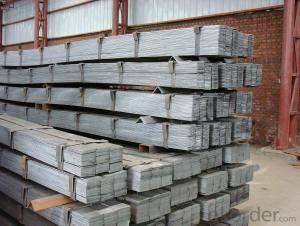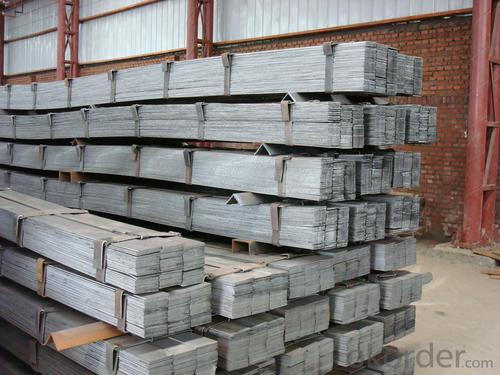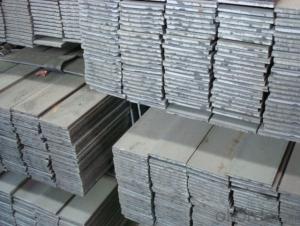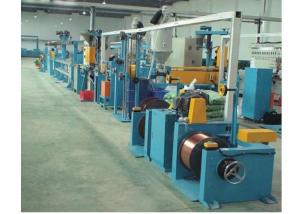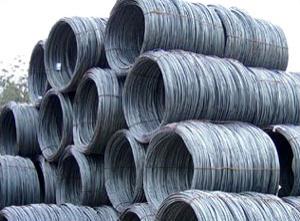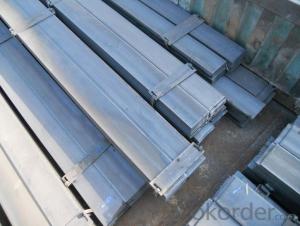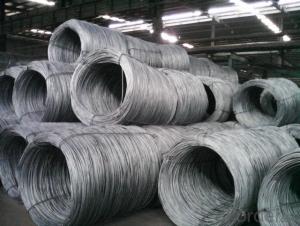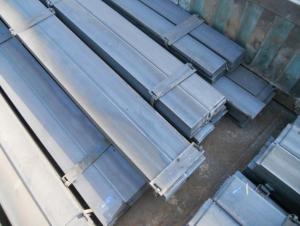Alloyed flat bar
- Loading Port:
- China Main Port
- Payment Terms:
- TT OR LC
- Min Order Qty:
- -
- Supply Capability:
- -
OKorder Service Pledge
Quality Product, Order Online Tracking, Timely Delivery
OKorder Financial Service
Credit Rating, Credit Services, Credit Purchasing
You Might Also Like
Quick Details
| Place of Origin: | Brand Name: | Model Number: | |||
| Material: | white: |
Packaging & Delivery
| Packaging Detail: | the package of the wire rod steel for construction is standard exporting package |
| Delivery Detail: | 30d upon recipt of L/C |
Specifications
the wire rod steel for construction that we offer have been used in civil construction work for years.
SPECIFICATION
1: WIRE ROD IN COIL
2. STANDARD: AISI,ASTM,BS,DIN,GB,JIS
3. STEEL GRAD: Q195--235/SAE1006B/SAE1008B/SA31012B/SDA31015B/SA31018B/SA31022B
4. SIZE: 5--22MM

1) the products that we offer haven been used in civil constrction work for years
2) meet different requirment
3) we can offer accordingly with different demands
- Q: What are the different types of coatings used on steel wire rod?
- Steel wire rods can be coated with various types of coatings, each having a specific purpose and providing unique benefits. Some commonly used coatings include: 1. Zinc Coating: Zinc is widely used as a coating for steel wire rods due to its excellent corrosion resistance. It acts as a protective barrier between the steel and the environment. Zinc coatings can be applied through hot-dip galvanizing or electroplating processes. 2. Polymer Coating: To enhance durability and resistance to abrasion, polymer coatings are often applied to steel wire rods. These coatings can be made from different types of polymers, like polyethylene or polypropylene, and are typically applied through extrusion processes. 3. Phosphate Coating: Phosphate coatings are used to improve adhesion between the steel wire rod and subsequent coatings or paints. They create a rough surface that enhances the bonding ability of other coatings, thereby increasing their effectiveness. 4. Epoxy Coating: For steel wire rods exposed to harsh environments, such as marine or industrial applications, epoxy coatings are commonly used. These coatings offer excellent chemical resistance and durability, protecting the steel from corrosion and degradation. 5. Chrome Coating: Chrome coatings provide a highly polished and decorative finish to steel wire rods. They are often used in applications where aesthetics are important, like in furniture or automotive component manufacturing. 6. Nickel Coating: In highly corrosive environments, such as marine or chemical processing applications, nickel coatings are used to enhance the corrosion resistance of steel wire rods. Nickel coatings can be applied through electroplating processes. 7. Copper Coating: Copper coatings are applied to steel wire rods to improve their electrical conductivity. They are often used in applications where the wire rod will be used for electrical purposes, like in wiring systems or electronic devices. It is important to consider the specific application and desired properties of the finished product when choosing a coating for a steel wire rod. Additionally, some coatings can be combined or modified to meet specific performance requirements.
- Q: What are the different types of coatings applied to steel wire rod?
- There are several types of coatings that can be applied to steel wire rod, depending on the intended use and desired properties. Some common types include galvanized coatings, which provide corrosion resistance through a layer of zinc; zinc-aluminum coatings, which offer enhanced corrosion protection and improved adherence to subsequent coatings; phosphate coatings, which improve adhesion for subsequent coatings and provide temporary corrosion resistance; and polymer coatings, which can provide additional corrosion resistance, lubrication, or insulation properties.
- Q: What are the different surface defects that can lead to failure in steel wire rod?
- Some of the different surface defects that can lead to failure in steel wire rod include cracks, pits, scratches, and surface decarburization. These defects can weaken the wire rod, reducing its strength and leading to potential failure during use.
- Q: How are steel wire rods used in the production of wire cables?
- Wire cables require steel wire rods as an essential raw material for their production. These rods are usually made from carbon or alloy steel and are shaped into long, cylindrical forms. They undergo several stages of processing to be converted into wire cables. Initially, the steel wire rods are hot rolled. This involves passing the rods through a series of rollers to gradually decrease their diameter and increase their length. This hot rolling process enhances the steel's ductility and strength, making it suitable for further processing. After hot rolling, the steel wire rods undergo a process called cold drawing. This process involves pulling the rods through a series of dies at room temperature to further decrease their diameter and increase their length. Cold drawing refines the steel's surface finish and improves its mechanical properties, such as tensile strength and flexibility. Once the desired diameter and length are achieved, the steel wire rods are used in the production of wire cables. They are fed into a wire drawing machine, where they are pulled through a series of dies to further decrease their diameter. This drawing process ensures the desired diameter and surface finish of the wire cables. Following the wire drawing process, the steel wire rods typically undergo a heat treatment to enhance their mechanical properties. This involves heating the rods to a specific temperature and rapidly cooling them to attain the desired hardness and strength. The final step in wire cable production involves stranding the steel wires together to form a cable. The individual steel wires are twisted in a specific pattern known as a lay, providing the cable with the desired strength and flexibility. This stranding process is often followed by a coating or galvanizing process to protect the wire cables from corrosion. In conclusion, steel wire rods are vital in wire cable production. They undergo various processes, including hot rolling, cold drawing, wire drawing, heat treatment, and stranding, to create strong, durable cables suitable for a wide range of applications.
- Q: What are the different rolling processes used for steel wire rod production?
- There are several different rolling processes used for steel wire rod production, each with its own advantages and applications. 1. Hot Rolling: This is the most common and widely used method for producing steel wire rods. The process involves heating the steel billets to high temperatures and then passing them through a series of rolling mills. The hot rolling process results in a more ductile and flexible wire rod, making it suitable for various applications such as construction, automotive, and manufacturing industries. 2. Cold Rolling: Unlike hot rolling, cold rolling involves rolling the steel wire rod at room temperature. This process helps to improve the surface finish and dimensional accuracy of the wire rod. Cold rolling also enhances the mechanical properties of the wire rod, making it suitable for specialized applications like high-strength wires, springs, and electrical conductors. 3. Continuous Casting and Rolling: This method integrates the casting and rolling processes into one continuous operation. Molten steel is directly cast into thin slabs or billets, which are then rolled into wire rods without any intermediate reheating. Continuous casting and rolling offer advantages such as improved efficiency, reduced energy consumption, and enhanced product quality. 4. Microalloying Rolling: In this process, small amounts of alloying elements are added to the steel composition to improve its strength and other mechanical properties. The microalloying rolling process is commonly used for producing high-strength wire rods used in construction, infrastructure, and automotive industries. 5. Thermomechanical Rolling: This rolling process involves a combination of hot rolling and controlled cooling to achieve specific mechanical properties. By controlling the cooling rate, the microstructure of the steel wire rod can be modified, resulting in improved strength, toughness, and formability. Thermomechanical rolling is often employed in the production of high-quality wire rods for critical applications like suspension cables, ropes, and steel reinforcement. Overall, the choice of rolling process for steel wire rod production depends on factors such as the desired mechanical properties, surface finish, and application requirements. Each rolling process offers unique advantages and allows manufacturers to produce wire rods tailored to specific applications.
- Q: How is steel wire rod used in the production of wire mesh for sieving?
- The production of wire mesh for sieving heavily relies on steel wire rods. These rods undergo a series of manufacturing steps to prepare them for wire mesh production. One such step involves drawing the rod through a die to decrease its diameter and increase its length, resulting in a thin and elongated wire. Once transformed into wire, it is then woven or welded together to form wire mesh. This mesh consists of intersecting wires spaced evenly, creating a grid-like structure with uniform openings. This design allows for efficient filtration and separation of particles based on their size. When manufacturing wire mesh for sieving, it is common to use steel wire rods. These rods are woven together using different techniques such as plain weave, twill weave, or Dutch weave, depending on the desired characteristics of the mesh. The properties of the wire rod, including strength, flexibility, and resistance to corrosion, are crucial in determining the quality and durability of the wire mesh. The strength of the wire rod ensures that the mesh can withstand tension and stress during sieving operations. Additionally, the flexibility of the wire allows for easy shaping and customization of the mesh to meet specific sieving requirements. Moreover, the resistance to corrosion of the steel wire rod prevents the wire mesh from deteriorating when exposed to moisture or harsh environmental conditions. This resistance is particularly important when the wire mesh comes into contact with liquids or substances that could potentially cause damage. Overall, the steel wire rod is an essential component in the production of wire mesh for sieving. Its transformation into wire and subsequent weaving or welding processes enable the creation of durable, reliable, and efficient wire mesh. This mesh finds wide application in various industries for sieving and separating particles of different sizes.
- Q: What are the potential drawbacks of using steel wire rod?
- Some potential drawbacks of using steel wire rod include its susceptibility to corrosion if not properly coated, its relatively high cost compared to other materials like aluminum or plastic, and its limited flexibility and maneuverability compared to other wire materials. Additionally, steel wire rod may be heavier and bulkier, making it less suitable for certain applications that require lightweight or compact solutions.
- Q: Can steel wire rod be used for cold drawing applications?
- Yes, steel wire rod can be used for cold drawing applications. Cold drawing is a process in which the wire is pulled through a die to reduce its diameter and increase its length. Steel wire rod, known for its high tensile strength and ductility, is commonly used in this process to produce various wire products such as nails, screws, and springs.
- Q: What are the different types of steel wire rod surface defect prevention and control measures?
- There are several types of steel wire rod surface defect prevention and control measures. Some of them include implementing proper cleaning and lubrication processes, using high-quality raw materials, ensuring proper temperature control during the rolling process, conducting regular inspections and tests for defect detection, and implementing effective corrective measures to address any identified defects. Additionally, maintaining a clean and controlled production environment, proper storage and handling of the wire rods, and ensuring skilled and trained operators also contribute to preventing and controlling surface defects in steel wire rods.
- Q: How does the tensile strength of steel wire rod vary with different diameters?
- The tensile strength of steel wire rod can vary with different diameters. Generally, as the diameter of the wire rod increases, the tensile strength also tends to increase. This is because a larger diameter provides more surface area for the material to resist deformation under tension. Additionally, a larger diameter wire rod typically contains more material, resulting in a stronger overall structure. However, it is important to note that the relationship between diameter and tensile strength is not linear. At a certain point, increasing the diameter of the wire rod may not significantly increase its tensile strength. This is because the material properties of the steel can also influence its strength. For instance, the grade of steel, its microstructure, and any additional treatments or heatings can affect the overall strength of the wire rod. It is also worth mentioning that other factors, such as the manufacturing process and any subsequent treatments, can also influence the tensile strength of steel wire rod. These factors include drawing processes, heat treatments, and alloying elements. Therefore, when considering the tensile strength of steel wire rod with different diameters, it is essential to take into account all these factors to accurately determine the relationship between diameter and tensile strength.
Send your message to us
Alloyed flat bar
- Loading Port:
- China Main Port
- Payment Terms:
- TT OR LC
- Min Order Qty:
- -
- Supply Capability:
- -
OKorder Service Pledge
Quality Product, Order Online Tracking, Timely Delivery
OKorder Financial Service
Credit Rating, Credit Services, Credit Purchasing
Similar products
Hot products
Hot Searches
Related keywords
